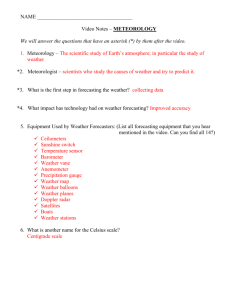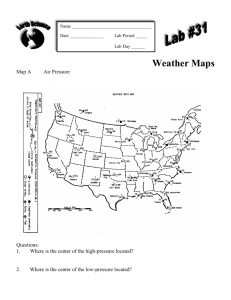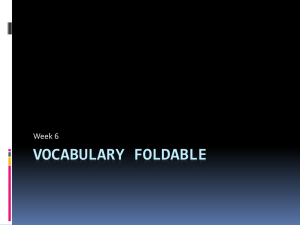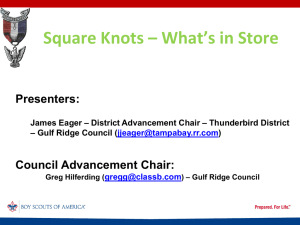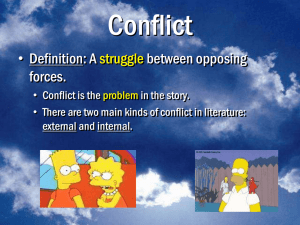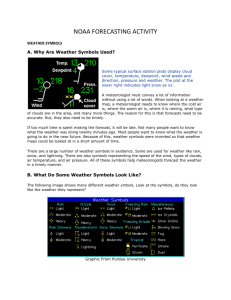WEATHER MAP INVESTIGATIONS: Questions 1-3
advertisement
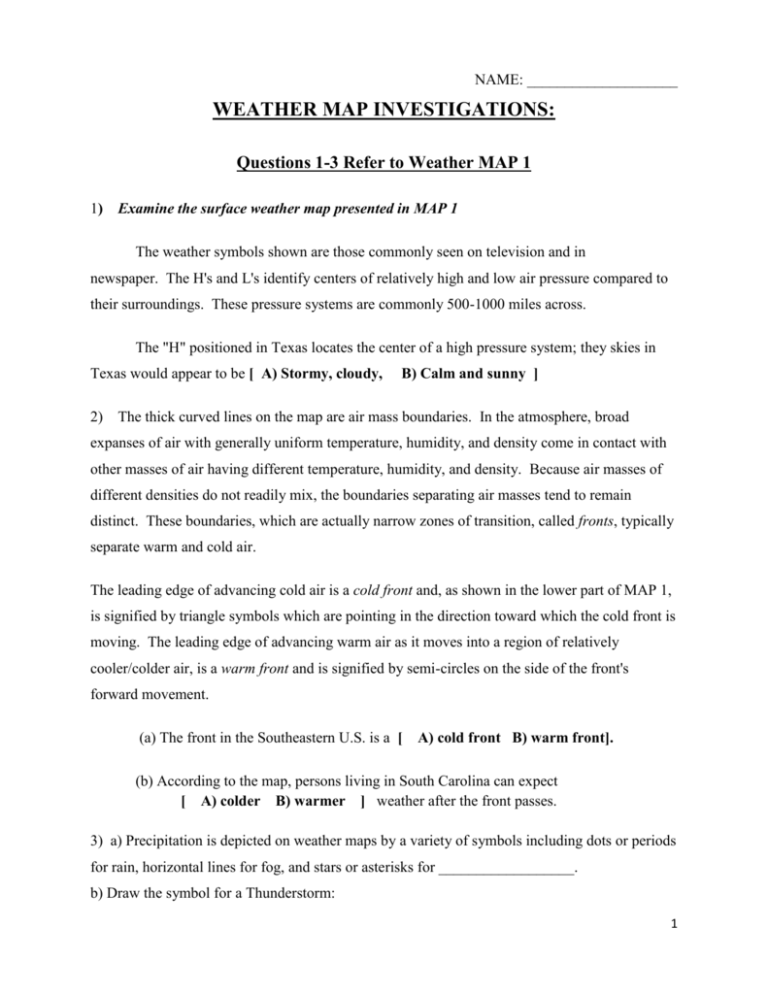
NAME: ____________________ WEATHER MAP INVESTIGATIONS: Questions 1-3 Refer to Weather MAP 1 1) Examine the surface weather map presented in MAP 1 The weather symbols shown are those commonly seen on television and in newspaper. The H's and L's identify centers of relatively high and low air pressure compared to their surroundings. These pressure systems are commonly 500-1000 miles across. The "H" positioned in Texas locates the center of a high pressure system; they skies in Texas would appear to be [ A) Stormy, cloudy, B) Calm and sunny ] 2) The thick curved lines on the map are air mass boundaries. In the atmosphere, broad expanses of air with generally uniform temperature, humidity, and density come in contact with other masses of air having different temperature, humidity, and density. Because air masses of different densities do not readily mix, the boundaries separating air masses tend to remain distinct. These boundaries, which are actually narrow zones of transition, called fronts, typically separate warm and cold air. The leading edge of advancing cold air is a cold front and, as shown in the lower part of MAP 1, is signified by triangle symbols which are pointing in the direction toward which the cold front is moving. The leading edge of advancing warm air as it moves into a region of relatively cooler/colder air, is a warm front and is signified by semi-circles on the side of the front's forward movement. (a) The front in the Southeastern U.S. is a [ A) cold front B) warm front]. (b) According to the map, persons living in South Carolina can expect [ A) colder B) warmer ] weather after the front passes. 3) a) Precipitation is depicted on weather maps by a variety of symbols including dots or periods for rain, horizontal lines for fog, and stars or asterisks for __________________. b) Draw the symbol for a Thunderstorm: 1 Question 4 & 5 Refer to SYMBOLS HANDOUT 4) Look at diagram below and answer the following questions: a) Temperature:__________ F. b) Wind direction is shown by the "arrow" shaft drawn into the circle representing the station. Unless otherwise noted, north is to the top on the page (map) and east is to the right. Wind is always named for the direction from which it blows. In the above depiction, the wind direction is from the _________________________. c) Wind speed is rounded off to the nearest 5 knots and is symbolized by "feathers" drawn on the clockwise side of the wind-direction shaft. A full feather represents 10 knots (11.5 mph) and half feathers indicate 5 knots. A pennant indicates 50 knots and a circle drawn around the station circle signifies calm conditions. i. In this case, the reported wind speed is ____________ knots. ii. Draw a wind barb that would indicate 50 knots iii. What is the speed of 10 knots? __________ d) Air pressure (adjusted to sea-level) is reported as a coded number to the nearest tenth of a millibar (mb). To decipher the plotted pressure value, first place a decimal point between the second and third number from the left. Then add a "9" or "10" to the left so that the resulting number falls within the range of air pressures that commonly occur at sea level (usually between 960 mb and 1050 mb). For example, a plotted value of 126 represents 1012.6 mb and 863 denotes 986.3 mb. The air pressure reported above is ______________mb. 2 e) Sky coverage (total amount of cloud cover) is reported inside the station circle. An empty circle indicates no cloud, a half-shaded circle means four-eights of the sky is cloud-covered, and fully shaded circle stands for a completely overcast sky. The reported cloud cover is _________________ . f) Current weather is plotted at the "9 o'clock" position on the station model (to the left of the station circle) using a variety of symbols representing the particular weather conditions. The reported current weather is ____________________ . 5.) Look at the diagram below to answer question 5 a) The recorded temperature is __________ b) The reported cloud cover is ___________ c) The reported current weather is _________ d) The wind speed is ____________ e) The wind direction is from the __________ f) The high cloud type is ______________ g) The dew point is _________ Questions 6-10 Refer to Weather MAP 2 6) The wind directions at stations in the central U.S. and Canada region around the high pressure center centered in Iowa generally show a [ A) clockwise B) counter clockwise ] circulation pattern typical of Northern Hemisphere. 7) At map time, St. Louis, on the eastern border of Missouri along the Mississippi River, had winds from the (a) ______________ at about 5 knots and the air pressure corrected to sea level was (b) __________________ mb. 8) At North Platte, in central Nebraska, the air pressure corrected to sea level was 1030.3 mb and at San Antonio, in south-central Texas, it was 1024.2 mb. (a) Which city, [ A) North Platte, Nebraska B) San Antonio, Texas ], was cooler? 3 The dewpoint is the temperature to which air must be cooled (at constant pressure) to achieve saturation (100% relative humidity). The higher the dewpoint, the greater the concentration of water vapour in the air. (b) From the reported dewpoints, the air in [ A) North Platte, Nebraska B) San Antonio, Texas ] contained less water vapour. This is consistent with the Canadian air mass that is affecting the north-central and north-eastern United States. 9) The boundary of continental polar air moving out of Canada is shown by a heavy blue line with triangles stretching from northeastern U.S. to northern Oklahoma. This line locates the position of a cold front. Greensboro in north-central North Carolina could expect [ A) cooler B) warmer ] temperatures in the next day or so. 10) Find the weather station that is near Regina, Saskatchewan. a) What direction is the wind coming from? ___________ b) What is the cloud coverage in Regina? _________________ c) What is the temperature in Regina? _______________ °F Questions 11-14 Refer to Surface Weather MAP 3 Isobars connect all points that have the same atmospheric pressure. They often produce closed loops within loops that help to identify high and low pressure systems. On Map 3, the isobars are the blue lines. 11) Centered over the Dakotas is a low pressure center on MAP 3. (a) Winds around this low pressure center are blowing in [ A) clockwise B) counter clockwise ] manner. (b) What frontal system is moving through North and South Dakota? ________________ 12) Extending toward the southeast from the "L" marking the center of the low pressure system over the Dakotas is a warm front. This front is indicated by a red line with semi-circles that point in the direction that relatively warmer air is moving into a region of relatively cooler air. This front is moving toward the [ A) north-northeast B) south-southwest ]. 4 13) On map 3 you can clearly see the isobars that cover 3 of Canada’s provinces. Which provinces appear to have the same atmospheric pressure? ______________________________________________________________________________ 14) a) Which location, Key West at the southwest tip of Florida or Phoenix, Arizona has the higher dew point? [ A) Key West, Florida B) Phoenix, Arizona] (b) Which location has the higher temperature in °F? [ A) Key West, Florida B) Phoenix, Arizona] Questions 15-17 Refer to MAP 4 Meteorologists combine information from dozens of weather stations and then create a map. Their first step is to draw lines called isotherms. Isotherms connect points of equal temperature. They are useful for locating air masses and locating frontal systems. Lines that are close together show that temperature is changing significantly over a short distance. This is what you would expect for a frontal system. On Map 4, the isotherms are the red lines. 15.) An isotherm is a line of constant ___________________________. An isobar is a line of constant ________________________________. a) Looking at MAP 4; can you find isotherms that are close together? Where are they located? ______________________________________________________________________________ ______________________________________________________________________________ b) What type of frontal system is near the isotherms that are close together? ______________________________________________________________________________ 16.) Find the weather station that is near Winnipeg. a) What is the sky cover in Winnipeg?_______________________ b) From what direction is the wind coming from? _________________________ c) What is the speed of the wind? _________________ 5 17) Find the weather station on the BC Alberta border. a) What direction is the wind coming from? ________________________ b) What is the temperature? _______________°F c) What is the barometric pressure? ______________mb d) What direction is the air circulating? [ A) Clockwise B) Counter clockwise ] 6
